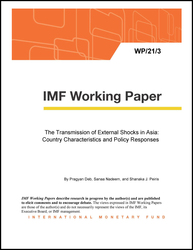
The Transmission of External Shocks in Asia: Country Characteristics and Policy Responses
The Transmission of External Shocks in Asia: Country Characteristics and Policy Responses
READ MORE...
Volume/Issue:
Volume 2021
Issue 003
Publication date: January 2021
ISBN: 9781513566115
$18.00
Add to Cart by clicking price of the language and format you'd like to purchase
Available Languages and Formats
| English |
Prices in red indicate formats that are not yet available but are forthcoming.
Topics covered in this book
This title contains information about the following subjects.
Click on a subject if you would like to see other titles with the same subjects.
Banks and Banking , Exports and Imports , Money and Monetary Policy , Spillovers , international financial cycle , balance sheet , transmission channels , foreign exchange intervention , monetary policy , macroprudential measures , capital flows measures , WP , investment EMs , EM investment , transmission mechanism , exchange rate channel , EM growth
Summary
Asian economies are increasingly integrated to the global economy through trade and financial linkages, exposing them to the international financial cycle. This paper explores how external shocks are transmitted to Asian economies and whether the use of policies, such as the monetary policy interest rate, foreign exchange intervention (FXI) and macroprudential measures (MPMs), can mitigate the impact of these external shocks. It uses panel quantile regressions on a sample of 14 Asian advanced and emerging economies (AEs and EMs) to assess the impact of financial and real shocks on investment and GDP growth at the median and 5th percentile tail. It finds that external financial shocks tend to have a larger effect on Asian economies than real shocks, and that the main transmission channels through which shocks are propagated are capital flows (particularly via corporate and bank balance sheets) for EMs, and credit for AEs. It also finds evidence that for Asian EMs, FXI may help dampen the capital flows and real exchange rate channels and mitigate financial shocks in the short run, and monetary policy transmission tends to be relatively weak; meanwhile MPMs can help mitigate the credit channel for both AEs and EMs.
Copyright © 2010 - 2025
Powered by:
AIDC



